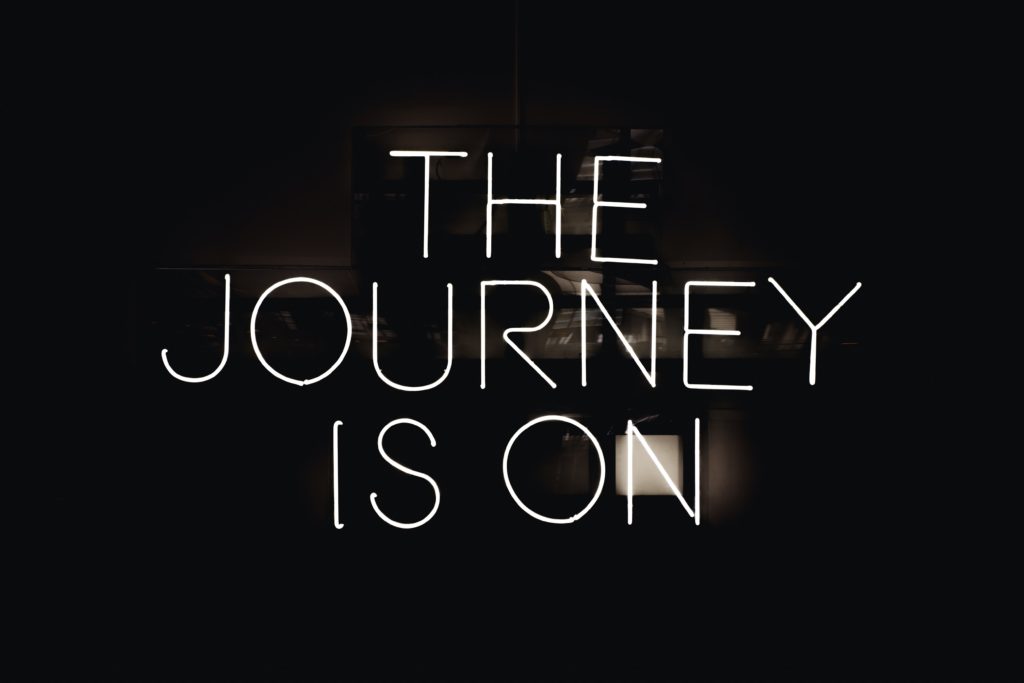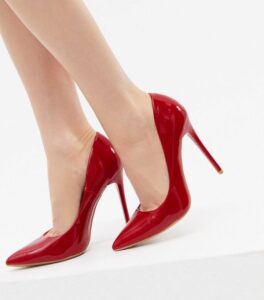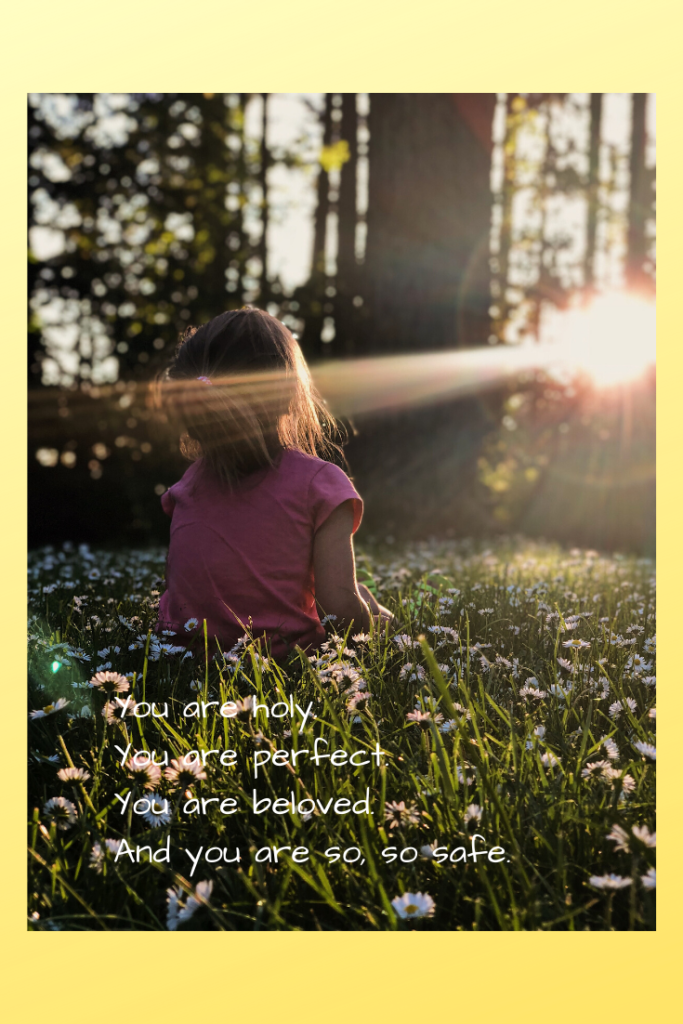| Imagine you’re at a trailhead in the wilderness. Sunrise is lightening the eastern sky, birds are singing their dawn song in the tops of the firs, and the creek beside your trail is burbling happily, full of fresh snowmelt, beckoning you upward. You’re excited to climb to the top of the mountain on the horizon, with the last of the night’s stars fading away behind it. You’ve wanted to climb this mountain for years, and today is the day. You take one last drink of water, shoulder your pack, strap on your hiking poles, and embrace the journey ahead. But then. A voice. It belongs to a young man emerging from the trees. He wears an official uniform and a badge, and he tells you to stop. “Hold up,” he says. “I’m going to give you some of these before you go.” He gestures to a table laden with a strange assortment of objects: rocks in ten-pound bags, pairs of shiny red stilettos, rolls of Cling Wrap, and heavy mittens. He tells you to remove your sturdy trail shoes and replace them with the stilettos, puts two bags of rocks in your backpack, and wraps your head in Cling Wrap in which he’s poked tiny holes for your nose and your mouth. You object, although it’s difficult through the plastic wrapped around your head. He says, “Sorry, ma’am. This is how it is. I don’t make the rules. Oh. I almost forgot. You have to give me half your food.” This seems strange to you. You wonder who’s making these rules, but you give the young man most of your lunch and start up the trail. You’re beginning to wonder if you’ll make it up that mountain. Thoughts create feelings which lead to actions that accumulate as results. Period. That’s what I learned in Wayfinder coach training, and it’s what I’ve taught clients myself. The idea is that once we can catch a thought causing suffering, we can do the work to change the thought. Because, thankfully, thoughts, unlike feelings, are changeable. (Changing an action without changing the thought(s) motivating the action is white-knuckling ourselves into a desired state. This “change through brute force” takes lots of will power, a finite resource.) This black and white, clear cut, linear formulation is the foundation of Cognitive Behavior Therapy (CBT), and it’s been helpful for many. Well. Turns out it’s not true, that feelings are always, 100%, no exceptions, caused by thoughts. Researchers are finding that what eases suffering isn’t changing the thought, but getting distance from it. Learning to detach from a thought causing suffering is one of the pillars of Acceptance and Commitment Therapy (ACT). I now have a broader understanding and therefore a more nuanced perspective on thoughts, feelings, and actions. Thoughtwork is great for thoughts causing suffering. We suffer when we take life’s inevitable pain personally. Thoughtwork used on pain, not suffering, is ineffective and potentially harmful. That said, “unhelpful thoughts create unhelpful feelings that lead to unhelpful actions” is true often enough that it’s worth having some basic thoughtwork tools in your toolbox to ease your suffering. I’ve been playing around with a new one, and want to share it with you. It’s called “Cruel, Sadistic Operating Instructions.” Cruel, Sadistic Operating Instructions I found this one in Carolyn Elliott’s book Existential Kink. (The book has a lot of wacky stuff IMO, but this tool is priceless.) She calls it “How to Beat Yourself Up (the Fun Way).” In Carolyn’s words: “Make your cruel, sadistic ‘operating instructions’ radically explicit.” Here’s how it goes. Dig deep and see if you can uncover the real rules you live by—your cruel, sadistic operating instructions. We find our cruel, sadistic operating instructions when we investigate where we’re suffering. You know what suffering feels like. It feels weighty, stuck, trapped, caged, stagnant, frustrating. Anger that never goes away. Despair that persists. Attempts to control the uncontrollable. Pain, by contrast, moves through us. Pain ebbs and flows. Pain is alive. Look where you feel deadness, and you will find your suffering. Here are some of my cruel, sadistic operating instructions: I must never, ever, ever expand and grow bigger than my childhood roles and identity. I must never, ever, ever, create something original—art, writing, a coaching process, a business—because it might be flawed or ugly and therefore unworthy of existence. The only thoughts that matter are the ones others think or have thought. I must always listen and never speak. I must never, ever, ever decide anything for myself. I must never, ever, ever feel exuberant happiness. I must never, ever, ever do anything I might not get perfect the first time. No mistakes, ever. And so on. Now, of course these aren’t true. They’re ridiculous—statements I would never, ever, ever say to my kids or to anyone else. I have managed to expand, create, think for myself, speak up, feel happy, and make decisions. But doing those things has been harder than they needed to be, because of my buried operating instructions. Articulating my actual cruel, sadistic operating instructions helps me see how they’re still controlling me. I’ve been white-knuckling myself past my operating instructions, feeling anxious and guilty when I break them. They’re buried deep. Like vampires, exposing these rules to the light takes away their power. Uninstalling the operating instructions that no longer serve me is a skill. And that’s where thoughtwork comes in. So, what’s going on with you, dear mountain climber? Well, you’re doing your best to get up that trail with all those impediments. After all, you think, this is how he said it needed to be. I don’t understand, but I don’t have a choice. This must be how everyone does it. Maybe there’s something wrong with me, that this is so hard. You walk and you walk and you walk, grinding out step after step in those god-awful shoes, sweat pooling under the Cling Wrap, trying to see through the layers of plastic film, carrying that heavy, heavy backpack. Until you just can’t anymore. You teeter your way to the creek bank, heels catching on rocks, ankles twisting, and slide down onto the grass. You shrug off your backpack, kick off those ridiculous shoes, rip the Cling Wrap from your head, and put your feet in the water. Cold water flows over your blistered feet, fir-scented breezes cool your sweaty head, your shoulders relax and soften. A Dipper flies downstream. You’re tapped out. You’ve hit a wall. You know you can’t go any further, and you so badly wanted to get to the mountain top. You sit, trying to accept your disappointment. Then you notice that the Dipper is in the creek in front of you, watching you. She’s been there for some time, perched on top of a log in the water on the other side of the creek, singing and dipping as Dippers do. The log is hollow, and inside the log is a box. You wade toward the log. The Dipper watches your steady progress, bopping up and down encouragingly. You reach the log and pull out the box. Behind the box, deep in the hollow log, is a pair of sturdy trail shoes, your size, in the color you always wanted but REI was always sold out of. Oh, hell no, you think. I am not wearing those ridiculous stilettos one more goddamn minute. You carry the shoes and the box back across the creek. Sitting there with your feet in the water, the fir-scented breeze playing with your hair, the sound of the creek in your ears, you open the box. Inside is the food you left with the young man at the trailhead—your turkey sandwich, your bag of Fritos, and your oatmeal cookie. You’re beginning to believe you can get to the top of the mountain after all. Why would I keep carrying this stuff?, you think. You pull the bags of rocks out of your backpack and empty them into the creek. You stuff the empty bags, the wad of sweaty Cling Wrap, and your lunch into the backpack, dry your feet, and put on your beautiful new shoes. They feel so good. You return to the trail and resume your journey toward the mountain that is your goal: snow-capped, sturdy, shining in the morning sun. You’re strong. You’re brave. And you’re really looking forward to getting to the top of that mountain. Those stilettos? They’re swinging jauntily off your backpack by their sparkly straps. You’re not sure yet what you’ll do with them, but you know it’ll be something good. PS. If you’d like to share your Cruel, Sadistic Operating Instructions, hit reply. Confidentiality guaranteed. You can also tell me what you’ll do with those damn stilettos. I’d love to know! PPS. If you’d like to explore your operating instructions together, I offer a no-cost, no-obligation Clarity Call. PPPS. Thoughtwork is an integral component of Being Embodied, my intensive coaching program. I’ve offered Being Embodied in a private format for two years. I’m excited to announce that I’m offering it as a group program for the first time, starting on April 19th. More information will be coming next week! My weekly-ish newsletter is where I share my latest writing, offerings, and news. You can subscribe here, and thank you! Photo credit: Amazon. |
Category Archives: Women at Midlife
Our integrity is our home.
Being alive blows me away. Every so often I’m gobsmacked anew by the miracle I am, and that you are. Animate, conscious meat sacks—bundles of aggregated Earth elements, able to sing and dance and tell stories. Able to learn. To remember.
Able to love. And to hate.
How crazy is this?!
This being alive thing is astounding! Awesome! Amazing! Wild!
I’m also able to know one day I’ll end. This self-aware, cohered dust that is me will return to the Earth from which I sprang. The miracle that is me will cease to exist in this form. This is, of course, true for every Earthling entity. I’m not special.
My friends in their 80s laugh at me—but I do fear aging and death. The other side of this amazing being alive thing is this amazing dying thing. I’ve already outlived both parents. I’ll be 80 myself in fifteen years.
I know how fast fifteen years goes. It’s not long.
Jed’s impending retirement has made this life of mine feel all the more urgent. For 50 years, I’ve been thinking someday I’ll get around to that. And next time I’ll do it different. Better. Somedays and next times are dwindling fast. I don’t have many do-overs left.
I want to live MY life, the life I’m meant to live. The life I choose for myself, not the one I’ve been trained to live. The life where I follow others’ rules and measure myself by others’ standards is a safe life. Safe, easy, and painful.
Now I see. This is what Lent is for: to examine my choices and conform them more fully to my values. So I won’t have regrets on my death bed. I want the Earthlings I love to know without an iota of doubt that I love them, through and through.
This revelation is nothing new, it turns out. Tradition and Mary Oliver have gotten here first.
Of course Lent is about mortality, says my husband when I share my revelation. He tells me Frederick Buechner said that Lent is for the big questions. Seven weeks to take meaning and mortality seriously.
And, of course also Mary Oliver, who asked What does it mean that Earth is so beautiful? And what shall I do about it? What is the gift that I should bring to the world? What is the life that I should live?
Living my life my way requires both going rogue and returning home. Following the direction of my heart will create more external conflict, as I bump up against established patterns and others’ preferences and expectations. Following my heart’s direction also means more internal peace, as the gap between my values and my choices narrows.
That gap hurts. That gap sucks energy. That gap is where I lose myself.
I want to close that gap. I want to recommit to myself and my priorities. Living in integrity with myself is self-ish. It’s also necessary, despite all the training to the contrary.
My integrity is my birthright.
Your integrity is your birthright.
Our integrity is our home.
PS. My newsletter is where I share my latest writing, news, and offerings. If you want to subscribe, you can do that here, and thank you!
[Photo: Natalie Rhea Rigg on Unsplash]
Are the Himalayas Far?

It’s 1983. I’m sitting behind our apartment in Tucson, the desert sunlight dappling down through pomegranates, creosote, and a grapefruit tree, doing homework from my University of Arizona post-bachelor’s teacher prep program. I’m 25 years old.
My husband joins me and says, “I’m thinking about starting the ordination process.”
“Oh. Okay,” I say. I remember feeling excited about a new adventure, and happy to go along for the ride.
“Well, thank you, I’d love to. Are the Himalayas far?”
Jed’s vocation has taken me places I never would have landed otherwise. Four years of seminary. Two babies. Six cities and five states—Massachusetts, New Mexico, Missouri, Illinois, and Oregon. Twelve houses. Nine jobs (for me).
I have friends all over the US, and a few in Europe. I’ve had a unique perspective on Church in action, both good and bad. I’ve enjoyed the benefits of Jed’s sabbaticals: England and Ireland, Iona, the Camino de Santiago.
This life has also been costly. 25-year-old Barb had no idea what she was saying yes to.
I’ve been doing this clergy spouse thing in one form or another for forty years, since the day Jed told me he wanted to pursue ordination as an Episcopal priest.
“Well, thank you, I’d love to. Are the Himalayas far?”
Jed recently announced that he’s retiring this summer. (Trinity, Bend readers: You’re awesome! I love you so much.)
We’ve been anticipating his retirement for years, imagining what it might be like and what we might do.
But now that it’s here, I’m noticing a part of me hanging on for dear life, resisting the upcoming seismic shift. As costly, painful, crazy-making, and occasionally lonely as these decades have been, this is the life and the marriage I know. This is the life I’ve conformed myself around. This is the life I’ve cut off pieces of myself to fit into.
Two primary threads weave this web of resistance, I think: my relationship to change, and the difference between soul and façade.
First, change.
We’ve all been doing this change thing since puberty, really. Followed by leaving home for the first time. Graduating from college. Committing to a life partner, and maybe deciding to become parents. These celebratory changes in the first half of life are then followed by a smorgasbord of the more complicated changes: Divorces. Serious Illness. Retirements. Big moves. Deaths.
Just because we’ve been doing the “Change Cha-Cha” for our entire lives doesn’t mean we know how to do it well.
Marriages, births, divorces, deaths, retirements, serious illnesses, big moves—they’re all Square One dissolution events.
Wayfinder Life Coaches learn this mantra for Square One: “I don’t know what the hell is going to happen … and that’s okay.” I’m changing this to: “I don’t know what the hell is going to happen … and I’m okay.”
To complicate matters, Jed and I have also got our feet in Square Two, as we begin to imagine concretely what these actual bodies of ours will do beginning in August. The Square Two mantra? “There are no rules … and that’s okay.” Modifying again: “There are no rules … and I’m okay.”
I’m also grappling with the loss that accompanies change. We’ll be leaving a community that is dear to us. Places that are dear to us. And people that are dear to us.
Underneath those obvious losses is a more subtle, sneaky thing poking my heart. I can’t tend to this sneaky thing until I see it. And to see it, I’ve had to sit still for a long time, look within, and listen to myself.
Which brings me to Soul and Façade:
That part of me that’s hanging on, asking for attention and poking me until I listen? It’s that social self I’ve constructed over more than six decades, buttressed by being “the rector’s wife” for so many years. It’s my façade, feeling itself in danger, clinging desperately for survival.
Social Self, False Self, Ego, Façade, Cultural Self—all are labels for the same necessary part of ourselves: the part we show to the world in order to get through our days. This façade, first formed in infancy and childhood, is continually refined throughout our first four or five decades. Finally, hopefully, we begin to let go of that false front in midlife, when it gets too damn heavy to carry around. If we do the work.
For so many years, it was just easier to be who I was expected to be than to seek for the pure strength of my Soul within me. And, of course, as kids we don’t have the option to say, “Screw you and your bullshit cultural rules. I’m gonna be ME!” We must figure out what behaviors will keep us alive, and those behaviors get wired in.
For the first time in our adult lives, Jed and I can let those roles drop away. We can be whoever we want to be, individually and together. Oh, the freedom of that! And the anxiety. We’re a little “deer in the headlights” right now. When those roles drop away, we’ll be vulnerable and naked. And new.
Who will I be?
Who will he be?
Who will we be?
“Well, thank you, I’d love to. Are the Himalayas far?”
Here’s what’s helping me to stay over my feet right now, this minute:
1. I’m remembering that the Change Cycle is baked into our Earthling DNA. Death and rebirth, over and over and over, is what life on Earth is all about. Even rocks get into it. Resistance is futile. I have the tools to ride this wheel. I have understanding. I have my mantras. I’m okay.
2. I’m intentionally discerning who’s speaking, who’s running the show. Is it my Social Self/False Self/Façade? Or is it my Soul? The façade part of me is scared shitless, really worried about doing this right, and bracing herself against all the impending loss. My Soul, however, when I get down to her, is peaceful, connected, and not the least bit worried. So I’m spending a lot of time being quiet and listening.
3. I’m paying attention to what feels good in my body. My body came into this world knowing what’s true for me. She still does. I simply need to use my skills, pay attention, and trust her guidance. Staying present and connected feels good. Worrying does not.
(These skills—Embodiment, Soul-based Living, and Skillful Change—are components of my Coaching Intensive program.)
What does this mean for my coaching practice? I feel comfortable committing to this work through June. After that, who knows? Not me. So if you’re feeling the nudge for private coaching, now is the time to connect for a Clarity Call.
I’m also creating a three-month Group Coaching Intensive to begin in March. Details to come! If you’d like more information about that, let me know.
Ooof! This is a long one. Thank you for hanging in with me!
Gratefully yours,
Barb
P.S. This is the blog version of my weekly-ish newsletter. That’s where I share my latest writing, news, and coaching offerings. You can subscribe here, and thank you!
Image: New Yorker cartoon, by Robert Weber
Your original blessing lives in your body.
You do not have to be good. You do not have to walk on your knees for a hundred miles through the desert, repenting. You only have to let the soft animal of your body love what it loves.
~Mary Oliver, Wild Geese
These famous words of Mary Oliver perfectly express my wish for this first step in remembering. We start with the body. Your body. Most of us, by the time we get to midlife, have lost touch with our embodiment.
Why is embodiment the first, most crucial remembering? Because your body does not lie. Your body is tuned to truth. Your body is your soul enfleshed. When you were born, your body was a pure, true expression of your wants, needs, and desires. Babies don’t tell falsehoods. Not at first. Over time we learn to hide our true selves as necessary to keep our caregivers attached and our little kid selves alive.
That’s why, of course, you lost touch with your body. It’s really hard to hold your body’s inner truth and the outer lies you learn to tell to survive. Especially when you’re a child.
Good news! Your original truth is still alive and well underneath all the faking you’ve had to do for decades. Your original blessing resides in your body.
Often when we start our work together, my clients tell me that they’re fluent in their body’s language. They do yoga. They meditate. They eat right and they exercise often. But as we dig deeper, they realize they really have no idea what their bodies are trying to tell them. What they’re actually fluent in is their thoughts about their bodies. Their ideas about their bodies. Their judgments about their bodies.
We’re often much more adept at mindfulness than bodyfulness.
So task one is to re-inhabit your body. Your beautiful, sweet, holy “God pod.” This marvelous “meat sack” that means you’re alive on Earth. Because this meat sack in which your mind has its being is the key to the garden of delights which is your life.
Remembering the beauty and original blessing of your body can take some time. And it will probably feel uncomfortable to return home to all the pain and memories you’ve stored in your flesh. Getting back in touch with your truth as communicated by your body will almost certainly create some havoc in your life as usual. Perhaps that’s why you’re here. Because maybe you know, deep down, that a little havoc is just what you need to reset your compass to your true north.
Here’s an Embodiment meditation you might like to try. (Click here for video version.)
Grounding Cord, adapted from Shakti Gawain:
Sit. Take three breaths. Imagine a long cord extending from the base of your spine down into the Earth. You could imagine this cord like the root of a tree. (If you prefer to stand, imagine the cord extending from the soles of your feet down into the Earth.)
Now, as you inhale, imagine Earth’s energy coming up through the cord into your body, up and up with every inbreath. The energy flows into your body as it rises, and continues out through the top of your head. Do this three times.
Now, as you exhale, imagine that the energy of the sun and stars and planets is coming down through the top of your head, down your spine, infusing your body as it flows down into the Earth. Do this three times.
Now, be with both energies. As you inhale, be with the energy coming up from the Earth. As you exhale, be with the energy coming down from the cosmos.
Keep inhaling and flowing Energy up, exhaling and flowing Energy down. Feel both energies intermingle and flow throughout your body.
We are Earthlings, made of stardust. We are Earthlings, made from dirt.
Take three breaths to finish.
Upcoming events:
A Summer Solstice Gathering:
Tuesday, June 21, 4 pm Pacific, Zoom. Free. Subscribe to email for the link.
Three workshops going deeply into the first three modules of my Self-Recovery Coaching Intensive: Embodiment, Awareness, and Ownership: July. Dates, times, and investment TBD. More info coming soon! Reply to this email and let me know if you’re maybe interested. (Today’s post is from the Embodiment chapter of my Coaching Intensive workbook-in-progress, delayed by Covid.)
Coaching Intensive Group starting in September: Ten weeks of step-by-step, carefully constructed classes covering the three phases of self-recovery: Remembering, Reclaiming, and Recommitting. Tentative investment: $1000. Details coming your way in August.
Private Coaching: Contact me to schedule a no-cost, no-strings-attached Clarity Call.
For current writing and events, please subscribe to my weekly-ish newsletter here, and thank you!
Photo Credit: Melissa Askew on Unsplash.
The quality of your peaceful presence matters.

Dear friends,
I turned 64 a couple of weeks ago. Growing old has been on my mind a lot lately. It’s been damn stressful up in my brain. Here’s what’s helping me, offered to those of you who are also thinking about growing old and feeling stressed about it.
We were at the coast last week for our annual post-Easter rest. (My Episcopal priest husband naps. I walk.) As is often true of the Oregon coast in April, the weather was wet and windy. But every evening for a couple of hours, the rain would taper off and I’d drag Jed down to the beach to watch the sunset. On this particular evening, the sunset was subtle. A solid bank of clouds out over the ocean seemed set to block the sun’s rays as it sank into the sea. The cloudy sky turned a beautiful mauve and pink, mist gathered at the base of Mount Neahkahnie, and waves reflected the sky back to itself.
We passed a photographer with his tripod at the waves’ edge, long lens pointed to where the invisible sun might be. A family of five, their big black poodle bounding in the surf, walked up the beach toward Manzanita, occasionally glancing toward the western horizon. Jed and I were ready to go inside out of the wind ourselves, believing we’d seen all the show there was to see.
We were wrong. Suddenly the sun peeked out from a hole in the clouds and shone right at us. Immense. Orange. Stunningly beautiful—clouds above, below, and all around the one little hole. The sun had an entire limitless Pacific horizon to choose from, and she came down in the one place she could shine through. We were awestruck. Through binoculars we watched the curvature of the sun slowly sink behind the clouds like mountains. Words cannot describe.
I turned to see if the photographer was catching this, hopeful that he’d capture the shot of a lifetime. He was walking up the dunes, tripod over his shoulder, his back to the beauty blazing behind him. The family of five was likewise walking up the beach toward Manzanita, seemingly oblivious, black poodle still bounding in and out of the waves. We watched until the last burnished edge of sun sank below the cloud bank, and reminded each other to breath.
If we’d let the wind and the wet keep us inside, if we’d turned our backs too soon, if I hadn’t brought my binoculars … We would have missed it.
What does this moment have to do with growing old? Here’s my takeaway. If I expect my old age to be a long slide into mellowness and mist, if I turn my back too soon, I’ll miss many extraordinary moments. We see what we expect to see.
Show up. Get out on the beach, no matter what the weather.
Be present with each step and each breath. The future radiates out from the present like a wave.
The quality of your peaceful presence in this moment determines how your future will feel.
Your thoughts about aging—your thoughts about anything, really—will strongly impact your experience. You can choose different thoughts, if you want to and you do the work. (Learning to notice your thoughts and how to choose better ones is a core component of my coaching work.)
Expect the extraordinary.
Carry binoculars just in case.
Love,
Barb
PS. Some resources I’m finding helpful:
This episode of Glennon Doyle’s We Can Do Hard Things with anti-ageism activist Ashton Applewhite
This Chair Rocks: A Manifesto Against Ageism, by Ashton Applewhite
PPS. Interested in talking more about aging and how to think more helpful thoughts about this inevitable change? I offer free, no-strings-attached Clarity Calls.
PPPS. I share coaching availability and current events in my weekly email newsletter. Want to subscribe? Click here.
Photo: Manzanita Beach, Oregon. 2022.
Loosen your unworthiness habit.
“I hope she always looks at herself like that … “ This is my friend’s wish for her four-year-old daughter. Her photo shows her daughter looking in the mirror, admiring her new French braid, and she’s simply ecstatic with herself.
We all used to look in the mirror like that. When was the last time you looked at yourself in the mirror and were completely satisfied, even ecstatic, with the woman looking back?
What happened?
What happened is culture, family, church, school, patriarchy. We’ve been told so many lies about women’s worth – our bodies, our voices, our places. We absorb them from birth, if not before. They’re in the air we breathe.
I spent three days last week in a quarterly retreat with 65 other mostly women entrepreneurs. We were asked to reflect on our biggest obstacle. Hands down the biggest obstacle was that we were “playing small.”
Why? Because we’re afraid that if we go big, get visible, and say exactly what we mean, we won’t be safe. Here’s what I wrote: “I believe that the real me is unlovable. So I have to send out fake me to fool everyone with my perfect façade. Staying small and fuzzy keeps me safe, and I have to feel safe at all times.”
I know that none of this is true. Yet my default pattern when I’m about to say something that I think someone might not like is to freak out and silence myself in advance. I default to “I have to prove that I’m lovable. And being lovable means no one will ever get mad at me and everything will always go smoothly.”
Ownership of ourselves comes after awareness of our patterns. I’m noticing this pattern, finally, and dismantling the thoughts that make me suffer. Because they’re lies.
You heal this oh-so-painful pattern by gradually, one-by-one, relieving yourself of the weight of those lies. Your belief in your belovedness is down there, underneath all the garbage. Beloved shiny you, the you who looks in the mirror ecstatically, will rise up, expand, and gradually take her rightful place as you lift off the garbage piece by piece.
How to lift off the garbage? Here are a few suggestions, in order of time commitment required.
High Five Habit: Basically all you do here is look yourself in the mirror and give yourself a high-five. For more, check out Kara’s Unf*ck Your Brain episode with Mel Robbins.
RAIN: Dr. Tara Brach’s four-step process for becoming aware of what’s going on with us and giving ourselves kind regard.
Awareness Wheel: A simple tool for self-awareness.
Thought Work: Dismantle those lies through gentle, self-compassionate inquiry.
And finally, find a photo of yourself as a child, frame it nicely if you want, and put it where you’ll see it all the time. Ask yourself if that kid is unworthy. Does she need to prove her belovedness? Would you let anyone else tell her she’s not okay just as she is?
Our habits of unworthiness are based on false beliefs.
There is no lasting safety in playing small.
There is no true joy in smooshing ourselves into little appropriate boxes.
Making our belovedness dependent on how others treat us only leaves us bereft of our own kindness and compassionate self-regard.
We’re still the beautiful beings we were when we were babies, toddlers, and four-year-olds, before we started to believe the hurtful lies. Beloved, your belovedness is a given. Your belovedness hasn’t gone anywhere. Your belovedness is within you, waiting for you to remember.
Who do you think you are? How do you treat yourself? These are ultimately theological questions, deeply related to our conceptions of Being and our place in the cosmos.
Want to go deeper? Contact me for a free no-strings-attached conversation.
PS. Happy holidays and happy New Year! I’ll see you in January, beloveds.
Photo Credit: Melissa Askew on Unsplash
How to use the holidays to grow your self-awareness.

The Way Out is a book about healing chronic pain, written by Alan Gordon. Gordon says the process he teaches is best used when you’re in pain. (Highly recommend, BTW.) He wants you in pain, but not too much pain.
The same is true for working with your emotional pain and suffering. You want to be in your pain enough that it’s easy to notice and feel, but not so much that you’re incapacitated. So, the holiday season might be just the ticket for unraveling an emotional knot or two. Thanks, holidays!
If you want to use these day to gain a little more self-knowledge, do I have a tool for you! The Awareness Wheel, mentioned in last week’s newsletter, is the best tool I know for noticing thoughts that cause suffering.
A holiday gift: my first video on my brand new YouTube channel. Download your blank Awareness Wheel here, then come join me as we work through it together on this 15-minute video. Thank you in advance for your gracious hospitality as I figure out how to do this. (I didn’t realize how often I coach with my eyes closed!)
Wheel by wheel, you can begin to unravel the gnarly clusterf*cks (technical coachy jargon) that cause you to suffer. Awareness is the ground of healing. Awareness is crucial. Awareness doesn’t obligate you to change anything. You can practice awareness without ownership, but you can’t practice ownership without awareness.
Wheels help you go places faster and more efficiently. As always, I’m here for a free, no-strings-attached Clarity Call.
Happy holidays, dear readers. Thank you for being here. I am deeply grateful.
PS. We’ll focus on Awareness Wheels during our December Community Conversation. Join me on Saturday, December 18th at 9:00 am Pacific to work through one together. I’ll send the link in next Thursday’s newsletter and again the morning of. You can subscribe here.
PPS. As a perfectionist in recovery, it’s hard for me to post this video when I see so much I could have done better. This is spur of the moment, completely unedited. And, I’m doing it anyway! Maybe I’ll do a wheel on the need to be perfect. I hope you enjoy it, and that you find it useful.
Photo by Maxime Horlaville on Unsplash




